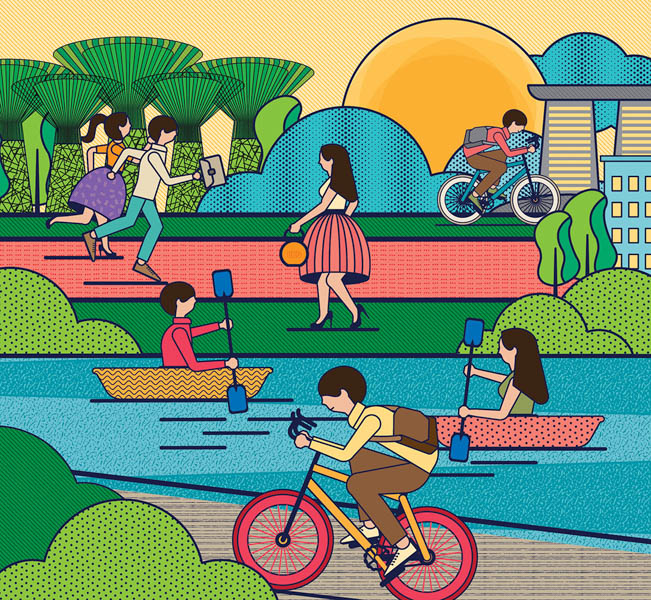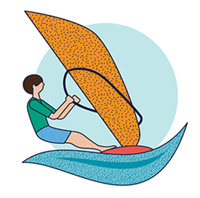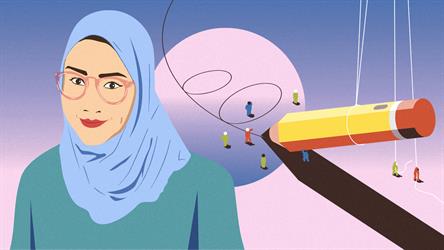Making Sports A National Habit: Efforts To Get Singaporeans Exercising

It was barely 9am on a Sunday but a dance party was underway at Sun Plaza Park in Tampines. Eighty perspiring bodies were grooving to the happy beats of Bhangra-Bollywood fusion.
“Okay, let’s move the shoulders up and down,” urged instructor Ms Rasidah Caudal as she led the crowd in the shoulder shrug, a classic Bhangra move.
“Now, change the light bulbs!” she continued, turning her wrists to demonstrate. The dancers of all ages raised their hands and followed. Stifled giggles came from embarrassed first-timers, while an old lady in a wheelchair gamely lifted her arms to join in.
This is what “Sundays @ The Park” in Tampines has looked like since Ms Rasidah and other trainers began giving classes, which are free to the public, last year.
The programme, a collaboration between the Health Promotion Board (HPB) and ActiveSG, brings gym classes like Masala Bhangra, Zumba, Bokwa, Kickboxing and Piloxing to the masses. They are also conducted in four other parks, in Sengkang, Sembawang, Choa Chu Kang and Taman Jurong.
“We make [classes] more relaxed and try not to scare [participants] off,” said Ms Rasidah. “We let them know… you don’t need to be super fit or be a professional dancer.”
The importance of being sporty
According to the 2010 National Health Survey, nearly 6 out of 10 Singapore residents do no exercise at all in their leisure time. It is no wonder then that the HPB hopes that such no-barrier classes will lure more away from their couches. The population’s increasingly sedentary lifestyle has been a major culprit in the uptick in diabetes and obesity rates in recent years.
Health concerns aside, there is the worry that a weak sports culture may deprive Singaporeans of the broader benefits of sports, such as leadership skills, sociability and learning to work as a team.
“To be successful, Singaporeans need certain skill sets and I truly believe you cannot get them in the classroom,” said Dr Ben Tan, a former national sailor who is now a sports doctor and a Nominated Member of Parliament.
He said the immense mental pressures he faced in the lead-up to and during sailing competitions toughened him, and helped him gain the confidence and resilience to cope with workplace challenges later in life.
Singaporeans’ tepid attitude towards sports worried Dr Tan enough for him to speak up in Parliament this January. Dr Tan highlighted 10 trends in mass sports participation, including a declining percentage of Singaporeans who exercised at least once a week, according to the five-yearly 2011 National Sports Participation Survey (NSPS), and the pragmatic approach of some schools to offer only the sports that their students excel in, i.e., winning at competitions.
Dr Tan also questioned if many do sports, not out of enjoyment, but to gain admission to schools or to pass compulsory physical tests. His speech struck a chord with Singaporeans and was shared widely on social media.
In reply, Minister for Culture, Community and Youth (MCCY) Lawrence Wong said the government was aware of the gaps Dr Tan had identified, and efforts were being made to address them. The issues had surfaced more than three years ago during public consultations for the Vision 2030 Master Plan, a 20-year road map that uses sports to achieve national priorities. The Plan recognises that sports can develop healthier and more resilient citizens, as well as unify communities through shared memories and stronger friendships.
Mr Wong also reassured Dr Tan that public feedback indicated a continued interest in sports. Smaller-scale surveys (not publicly available) showed that the number of people exercising at least once a week had increased to above 60% in 2013 and 2014, up from 42% in 2011, he said. (Read both speeches at https://www.mccy.gov.sg/about-us/news-and-resources)
Bringing sports to the doorstep

According to the 2010 National Health Survey, the top three reasons for physical inactivity given by Singaporeans were: “no time” due to work or family commitments, “too lazy” and “no interest”.
“Lack of time” was again the top reason why people stopped exercising, said the 2011 NSPS. A comparison of working hours per week reported by respondents in 2005 and 2011 showed that the proportion of those who worked more than 60 hours per week had more than doubled from 6.3% to 16.6%.
To tackle the issues of time and inertia, the HPB locates its free fitness programmes at accessible gyms, malls and parks, “to make it easier for Singaporeans to integrate physical activity in their daily lives”, said its spokesperson.
For instance, its “Sunrise in the City” programme helps working adults squeeze in exercise before work, during lunch time and on weekends, at gyms near their workplace. The programme, which started with 200 subscribers in 2013, now has 3,000 who pre-book classes like yoga, Bokwa and kickboxing monthly.
Last year, ActiveSG – an outcome of Vision 2030 – was launched to create a vibrant sporting ecosystem in Singapore. All Singaporeans and Permanent Residents are automatically members but those who activate their membership get a $100 credit that can be used to book ActiveSG facilities, buy swim and gym passes, and pay for its programmes.
Its Chief, Mr Lai Chin Kwang, said that every day, thousands activate their membership. In April, about 60% of its 740,000 members had used the credits, mainly for swimming and gym, and to book tennis and badminton courts, and soccer fields. Gym usage at ActiveSG sports centres is now about 20% higher than before.
Sparking an early interest
Making sports accessible and affordable may nudge more to pick up their rackets or put on their swimsuits. But to begin with, there must be interest.
After all, when one lives and breathes sports, he or she will find the time to do it.
Ms Catherine Lee, a former national netball player, continued to play competitively for a club even after her children were born. This, she said, was made easier with childcare help from her mother. Ms Lee grew up in a family of sports lovers; her husband, whom she met in school, played tennis, softball and soccer. Today, her daughter shares her love for netball while her son is into badminton and taekwondo. When Ms Lee has a match, the extended family, including nieces who play netball, turns up to cheer for her.

School is another place where a love for sports can be seeded – think of the times you played catch during recess time or football after school. Physical Education (PE) hours have increased to at least two hours per week, and many students are now offered a variety of sports co-curricular activities (CCAs) from Primary 2.
“PE has changed from the time Challenge readers were students,” said Ms Liew Wei Li, Director of Student Development Curriculum Division at the Ministry of Education (MOE). Before, “our teachers who taught the academic subjects would organise PE classes… [but] now we have specialised PE teachers.” These professionals design fun and active lessons and lately, outdoor adventure education has been added to the mix.
But Ms Liew acknowledged that “two hours per week is not enough for a healthy child” so the aim is to make PE enjoyable and expose students to a wide range of sports. “Helping [them] find a sport they like and can play well, will … help them continue playing it after school and on weekends.”
The MOE also runs the Sports Education Programme with Sport Singapore. This gives schools funding to hire external vendors for extra sports activities. Last year, Ms Liew said, students from 300 schools got to try sports that their schools did not teach, such as ice-skating, windsurfing and tchoukball.
A SOCCER MUM SHARES

He did not stop playing competitively during the year of his Primary School Leaving Examination. “The only way I saw him de-stress was in the field,” said the mother of three. “I don’t know where he finds the time to study but this year he did better than before.” Ms Chong added that while winning spurs his competitive streak and adds to his confidence, losing has presented him with opportunities to reflect and to grow stronger.
Creating opportunities

Dr Tan pointed out that “it’s not natural to be active” in a highly urbanised society like Singapore. “If you leave it to happen naturally, our sports participation will drop,” he said, stressing the importance of providing opportunities to sustain interest in sports.
Many parents are already doing so by sending their offspring to private clubs and classes. While these efforts are commendable, Mr Francis Ng, Vice-President of the Singapore Canoe Federation (SCF), is concerned that this could cause sports to become “stratified” in Singapore as those with extra coaching gain a vast head start.

Hence, to keep “pathways to sport accessible”, the SCF will offer a free children’s kayaking programme this year. Mr Ng hopes schools and other National Sports Associations will do the same so that the pursuit of sports by children will be “dictated by interest and not family finances”.
“[Otherwise], there’ll come a time when potentially gifted athletes may never be discovered simply because they were not given the opportunities to try out a particular sport,” he said. The SCF also plans to approach primary schools to introduce kayaking as a CCA, with the free use of its equipment thrown in.
This year, ActiveSG aims to give students more sporting opportunities by working directly with individual schools to develop customised support in terms of coaching assistance or the use of facilities.
For example, it has offered Cedar Girls’ Secondary School – a top track and field contender – the use of its “Home of Athletics” (the former Kallang Practice Track), now that the school’s 400m circuit will be making way for a housing development.
It has also worked with the Basketball Association of Singapore to create a new development league. This platform allows teams that fail to reach the National Inter-School Championships to continue to compete.
“In any competition, the winners move ahead but we may not be conscious that the team that lost would be the team that we need to build,” said Mr Lai, “so we created this [so they] get to play again.”
He added that a similar “Losers Stay” format has been introduced to ActiveSG’s open houses and leagues to challenge the prevailing mindset of focusing on winners. Instead of packing up after losing, the teams stay back to compete with other losing teams. “The parents who see this are intrigued,” said Mr Lai with a smile.
MORE ROOM TO PLAY

A common complaint among sports lovers has been the lack of recreational space in Singapore. Under Vision 2030, regional sports centres, as well as sheltered playing areas and multi-use courts in housing precincts, will be built. Existing facilities are being upgraded.
To maximise the use of schools’ sports facilities, the MOE and MCCY introduced the Dual-Use Scheme in 2011 to allow public usage. Currently 90 school fields, 50 free-to-play fields and 60 indoor sports halls are available for booking via the ActiveSG website. The aim is for all MOE schools to come under the scheme eventually.
Don’t preach to the choir
Changing the mindset of Singaporeans towards sports isn’t easy, especially as more become hooked onto their digital devices.
“My worry was: if we just start off by telling people how important sports is, you will only get the like-minded,” said Mr Lai. So in late 2013, he created a carnival-like ambience for an ActiveSG pre-launch event and filled up a public pool with colourful floats. The unconventional move raised eyebrows even within Sport Singapore.
“The strategy… gave us the first return we needed: kids saying ‘I want to come back next week.’ If the kids come, the parents will come and I’ll have two audiences to engage,” reasoned Mr Lai. Once their imagination is captured, he aims to engage families with creative programmes (that must evoke a “wow” reaction) so that parents can see the value of what ActiveSG is promoting.
He’s got an uphill battle ahead: The 2011 NSPS reported that 55% of parents with children below 12 years old had no child doing any sport outside school.
Still, Mr Lai has some reason to be optimistic. Since November 2013, all of ActiveSG’s paid School Holiday Sports Programmes – such as archery or futsal camps, as well as family bonding activities – have been mostly fully subscribed.
Dr Tan believes that if children are allowed to do sports for sports’ sake, they will develop a lifelong relationship with it. But this would require the adults to change their current attitude towards sports.
“I look forward to more and more parents – and consequently their children – adopting the right mentality and participating in CCAs for the right reasons,” he said in Parliament.
If more parents begin to think like Debra Chong and Catherine Lee, there is a good chance that Singapore can grow a vibrant sporting culture.
As the minister, Mr Wong, put it, “We are not quite at Finland which is 70-something per cent [in sports participation rate], but we are making progress.”
QUESTIONS DR BEN TAN WISHES THE MEDIA WOULD ASK HIM

“Without fail, before each major Games, the media will ask me, as President of Singapore Sailing, what is our medal target and whether we are on track. Do they ever ask me whether our sailors truly enjoy sailing, whether they are familiar with Singapore’s rich maritime history, whether our sailors see sailing as a lifelong pursuit, whether they are inculcated with the desired values, or whether we have sailors who sail for reasons other than medals?”
- POSTED ON
May 1, 2015
- TEXT BY
Bridgette See
- ILLUSTRATION BY
Ng Shi Wei
-
Deep Dive
Strengthening Singapore’s Food Security
-
Out of Office
Breaking the Routine: Officers on Alternative Sports









